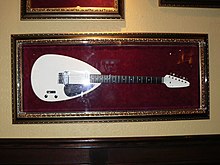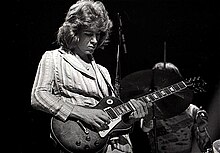
A drum kit is a collection of drums, cymbals, and sometimes other auxiliary percussion instruments set up to be played by one person. The drummer typically holds a pair of matching drumsticks or special wire or nylon brushes; and uses their feet to operate hi-hat and bass drum pedals.

Daniel Edwin Carey is an American musician and songwriter who is the drummer for the progressive metal band Tool. He has also contributed to albums by artists such as Zaum, Green Jellö, Pigface, Skinny Puppy, Adrian Belew, Carole King, Collide, Meat Puppets, Lusk, and the Melvins.

Jon Fishman is an American drummer and co-founder of the band Phish, which was, in part, named after him. He is credited with co-writing nineteen Phish songs, eight with a solo credit.
Slingerland is a United States manufacturer of drums. The company was founded in 1912 and enjoyed several decades of prominence in the industry before the 1980s. After ceasing operation in the early 1980s, Slingerland was acquired by Gibson, who briefly revived it and owned it until November 2019, before selling Slingerland to DW Drums, who announced the intention of re-launching the brand. Slingerland is strongly associated with jazz drummers, such as Gene Krupa and Buddy Rich, who played signature instruments made by the company. Although primarily known for its drums, in the 1930s Slingerland also produced electric and acoustic guitars, violins, mandolins, banjos and ukuleles.

Josh Eric Eppard is an American musician from Kingston, New York and the drummer for progressive rock band Coheed and Cambria. He has worked as a solo rapper under the name Weerd Science and was the drummer for supergroup rock band Terrible Things. Josh was a founding member of the Woodstock, NY new prog outfit 3 along with his brother Joey and studio engineer Chris Bittner.

Andrew Newmark is an American session drummer who was a member of Sly and the Family Stone and has played with George Harrison, John Lennon, Pink Floyd, David Bowie, Carly Simon, Ron Wood and Roxy Music.

Cocktail drums are a type of portable drum kit that combines bass drum and snare drum sounds in a single drum.

Christopher Aubrey Shiflett is an American musician. He is the lead guitarist for the rock band Foo Fighters, which he joined in 1999 following the release of the band's third album There Is Nothing Left to Lose (1999). Shiflett was also previously a member of the punk rock bands No Use for a Name (1995–1999) and Me First and the Gimme Gimmes (1995–2019).
Damon Che is a rock drummer and guitarist. He has contributed to indie rock and progressive rock through his work with math rock pioneers Don Caballero since 1991. His style is heavily influenced by metal, hard rock, punk, jazz, and fusion.

Steve Jordan is an American musical director, producer, songwriter, and musician. Currently, he is the drummer for the Rolling Stones. During the 1970s and 1980s, he was a member of the bands for the television shows Saturday Night Live and Late Night with David Letterman.

James Patrick Keeler is an American rock music drummer from Cincinnati, who is best known for playing in The Greenhornes, The Raconteurs, and The Afghan Whigs. He plays with both traditional and matched grips.

Thomas Armon Pridgen is an American drummer, best known for his role as the drummer of The Mars Volta from 2006 until 2009. He is touring with rapper Residente and is the drummer for hardcore punk band Trash Talk, as well as his own project The Memorials. In 2023 he joined Fever 333.

Jean-Paul Gaster is an American musician who is the drummer for the rock band Clutch.
Derek M. Kerswill is an American musician best known for his drumming in the bands Unearth, Seemless, Kingdom of Sorrow, and multiple fill-ins/studio projects. While no longer on the road, he continues to play in several bands in the greater Boston area.

Richard Robert Woolstenhulme Jr. is an American musician and the drummer of rock band Lifehouse.

Marc Stewart Danzeisen is an American drummer and musician. He is best known for his work with Riverdogs, Gilby Clarke, Little Caesar, his contributions to Def Leppard, and his appearance in the 1995 film, The Brady Bunch Movie.
Walberg and Auge is a United States drum kit and hardware manufacturer established in 1903 in Worcester, Massachusetts by Barney Walberg. Walberg and Auge is considered by some to be, "the biggest unknown name in the history of twentieth-century American percussion." The brand is credited with several innovations in musical instruments and associated hardware including the development of the modern hi-hat stand and shell-mounted tom-tom holder. The magazine Modern Drummer detailed the origin story of the modern hi-hat configuration: "After months of experimenting, Walberg's company extended the inner rod and outer tube of his low hat stand to about waist high so he could play the cymbals with his hand as well as his feet." The pivotal innovation was sold by every major drum company under the rubric "Perfection Hats."
Alex Bailey is an American multi-instrumentalist. He is most known for performing with bassist Marcus Miller. He is also known for his drumming on the Walt Disney movie, Safety.

Schlagenheim is the debut studio album by English rock band Black Midi, released on 21 June 2019 through Rough Trade Records. The band recorded the majority of the album over a five-day period with producer Dan Carey at his studio in South London. Throughout its recording, the band made the conscious decision not to replicate their live set, embellishing their four-piece setup with synthesizers, sequencers, drum machines, banjos and organs.

















